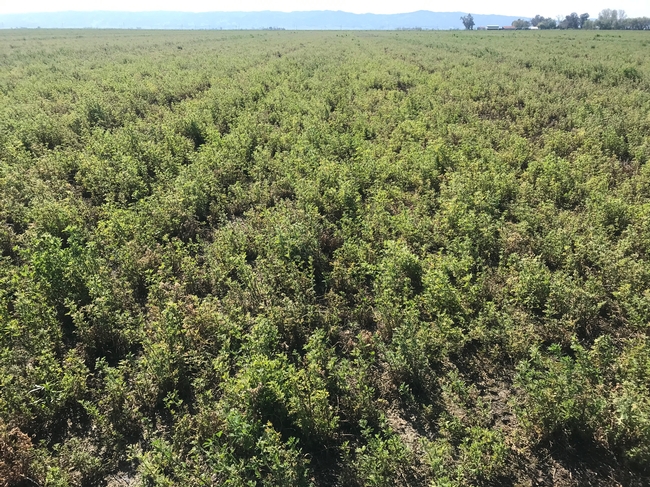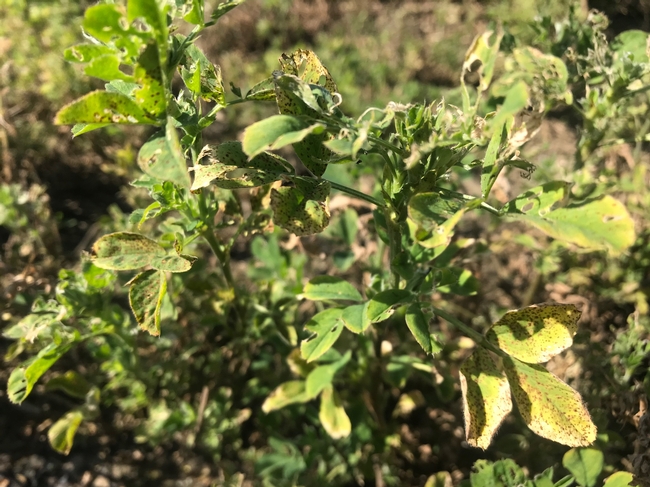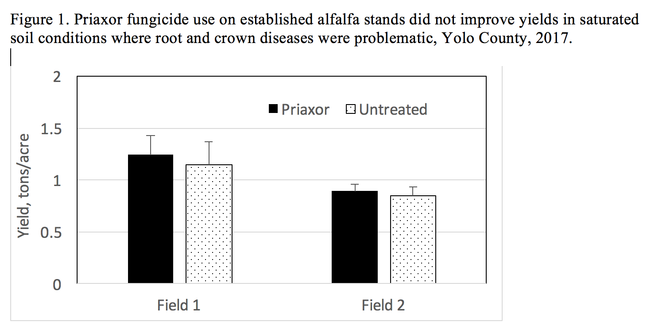It is both a blessing and a curse that alfalfa in California's Central Valley essentially grows all winter long. Although we can get very high early yields, if conditions are too wet, the fields look pretty ragged after a winter which saw rains in excess of 130% of normal.
However, alfalfa is a resilient crop and can likely recover from disease infestations.
Here comes the sun. Warmer, drier weather in the coming weeks is just what we need to dry out water-logged alfalfa fields and get them growing. Rainy, cold weather is a double blow for plants, especially in saturated soils where the crop is growing slowly, so it is more susceptible to diseases favored by moisture. This includes foliar diseases, like common leaf spot that covers leaves with brown dots and root and crown rots.

The use of fungicides in alfalfa. How well do they work?
For seedling fields where stand losses are possible, the use of fungicides in some situations can help protect plants from foliar diseases such as white mold, common leaf spot, or downy mildew that reduce plant vigor and stands (see blogs on Downy mildew, an unusual visitor, 2016 and Common leaf spot in alfalfa is common this year).

Are Fungicides Economical? Probably not in most cases. For established stands, it's best to wait for better weather conditions that favor good plant growth and discourage diseases, as the use of fungicides in established stands is probably not economical. In 2017, another wet year, we evaluated Priaxor, a systemic fungicide for disease control in two established alfalfa fields, applied February 15 in one field and March 8 on another. Priaxor (fluxapyroxad+pyraclostrobin) has good efficacy on foliar diseases, including downy mildew, leaf spots (common and stemphylium), and spring black stem (Phoma).
Yields were taken in both fields at first cutting on April 24 and 25, with no clear differences in tonnage between Priaxor treated and untreated plots (Fig. 1). We suspect that the plants were not actively growing, due to saturated soils from flooding, so were probably not taking up the fungicide for protecting new growth. In addition, there were issues with root and crown diseases in these fields, including Phytophthora, Pythium, and Rhizoctonia that were negatively impacting yields, more than the foliar diseases.
The crop just needs favorable conditions and time to recover from such attacks.
Although it may be tempting to spray fungicides for disease control in established alfalfa fields, the reality is that it's probably not economic. One may get some yield and quality losses with foliar diseases, but these should mostly clear up by the second cutting, when the weather becomes warmer and drier.
Best management Practices for managing diseases in alfalfa. Good agronomic practices go a long way to helping alfalfa plants resist diseases. This includes
- Planting alfalfa early in the fall so plants are well established going into winter, making them more resilient to diseases.
- Choose alfalfa varieties that are resistant to pests and diseases of importance in ones growing area, for example, Phytophthora resistance for alfalfa growing on heavy soils.
- Leveling fields so there are no low spots where water can pool, or planting on beds so water can drain is also important, particularly in heavy soils.
- Assuring proper drainage (e.g. subsoil drains) so that fields are less likely to be saturated.
- Controlling irrigation water to prevent standing water and excess moisture.
- In the summer periods, do not cut crop extremely frequently, which weakens the root system.
- Identifying diseases to determine whether early fungicide use would be helpful (for example with Sclerotinia).
